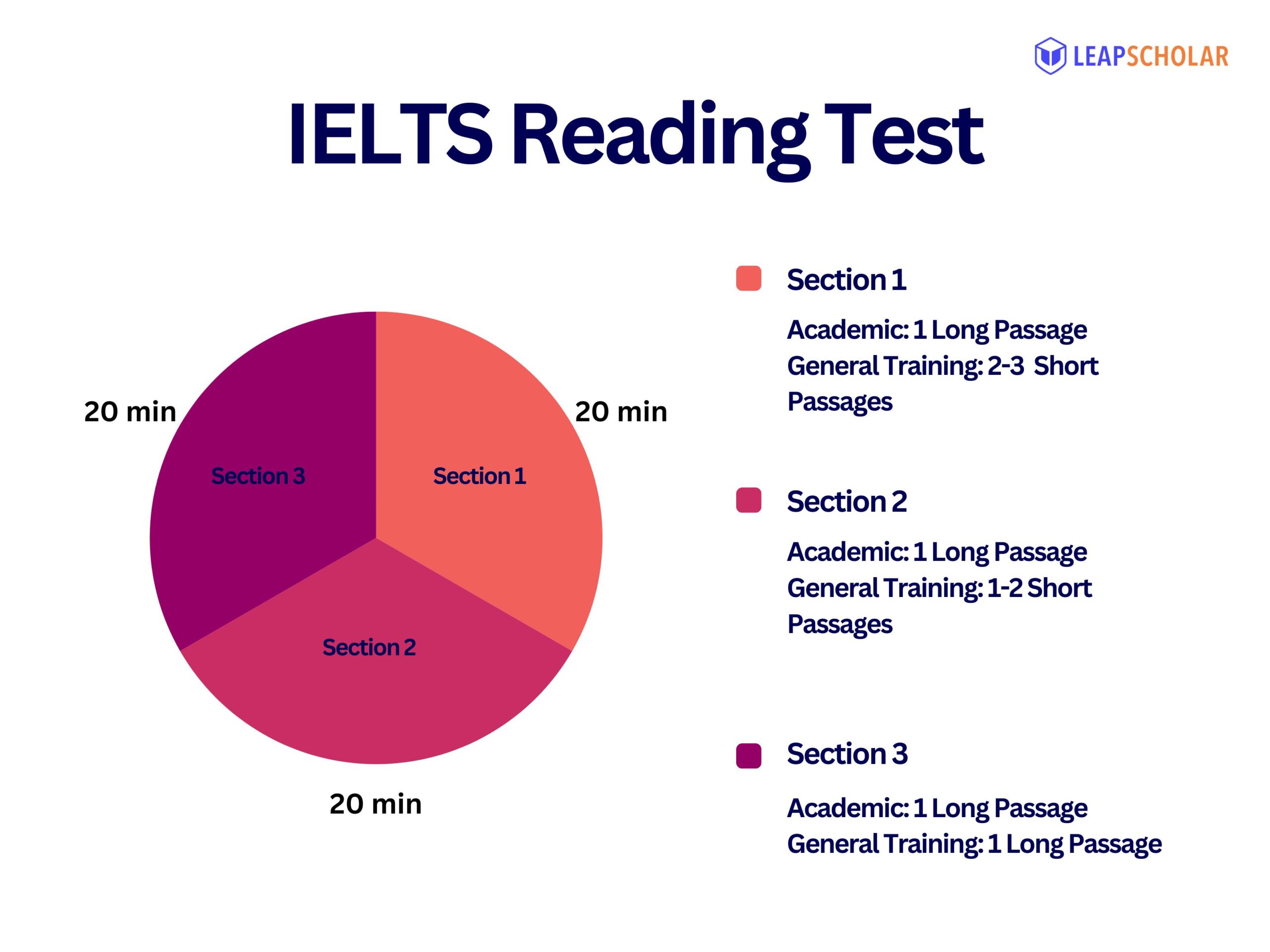Persistent practice is the quickest way to ace your IELTS Reading preparation. Let us start with the Trees in Trouble Reading answers.
The IELTS, or the International English Language Testing System, is an internally standardised English language proficiency test accepted across 140 countries. The test comprises 4 modules: Reading, Writing, Speaking and Listening.
The IELTS Reading test is a one-hour test that assesses your English reading skills. Given below are the test details.
Check out the details of the IELTS Reading Test:
| Duration | 60 minutes |
| Number of Questions | 40 |
| Number of Section | 3 |
| Number of Passages | General Training: 4- 6 Academic: 3 |
| Band Score | 1-9 |
| Question Types | – Identifying Information – Identifying a Writer’s Views/Claims – Sentence Completion – Summary, Note, Table, Flow-chart Completion – Diagram Label Completion – Short-answer Questions – Multiple Choice Questions – Matching Information – Matching Headings – Matching Features – Matching Sentence Endings |
The IELTS Reading test consists of three sections and each section is recommended to finish within 20 minutes.

The given Trees in Trouble passage explains the importance of big trees for the world and details how their destruction causes various impacts on the environment. It also specifies the numerous factors that cause this damage. Read the passage carefully and answer the questions followed by it.
The given passage comprises two question sets:
- Matching Headings
- Note Completion questions.
Check out the Trees in Trouble Reading answers below, with references and detailed explanations.
Leap Advantage Virtual Spot Offer Event on May 10th 2024

Last call to secure your spot for Masters in STEM Program in the US for Fall ’24 exclusively for graduates and above.
Leap Advantage Virtual Spot Offer Event on May 10th 2024
Last call to secure your spot for Masters in STEM Program in the US for Fall ’24 exclusively for graduates and above.

Trees In Trouble Reading Passage
Check out the Trees In Trouble reading passage below. Read the passage carefully and answer the following questions.
Trees in Trouble
Paragraph 1: Big trees are incredibly important ecologically. For a start, they sustain countless other species. They provide shelter for many animals, and their trunks and branches can become gardens, hung with green ferns, orchids and bromeliads, coated with mosses and draped with vines. With their tall canopies (leaves and branches that form a cover high above the ground) basking in the sun, they capture vast amounts of energy. This allows them to produce massive crops of fruit, flowers and foliage that sustain much of the animal life in the forest.
Paragraph 2: Only a small number of tree species have the genetic capacity to grow really big. The mightiest are native to North America, but big trees grow all over the globe, from the tropics to the boreal forests of the high latitudes. To achieve giant stature, a tree needs three things: the right place to establish its seedling, good growing conditions and lots of time with low adult mortality(no. of deaths within a particular group). Disrupt any of these, and you can lose your biggest trees.
Paragraph 3: In some parts of the world, populations of big trees are dwindling because their seedlings cannot survive or grow. In southern India, for instance, an aggressive non-native shrub, Lantana camara, is invading the floor of many forests. Lantana grows so thickly that young trees often fail to take root. With no young trees to replace them, it is only a matter of time before most of the big trees disappear. Across much of northern Australia, gamba grass from Africa is overrunning native savannah woodlands. The grass grows up to four metres tall and burns fiercely, creating super-hot fires that cause catastrophic tree mortality.
Paragraph 4: Without the right growing conditions trees cannot get really big, and there is some evidence to suggest tree growth could slow in a warmer world, particularly in environments that are already warm. Having worked for decades at La Selva Biological Station in Puerto Viejo de Sarapiqui, Costa Rica, David and Deborah Clark and colleagues have shown that tree growth there declines markedly in warmer years. “During the day, their photosynthesis shuts down when it gets too warm, and at night they consume more energy because their metabolic rate increases, much as a reptile’s would when it gets warmer,” explains David Clark. With less energy produced in warmer years and more being consumed just to survive, there is even less energy available for growth.
Paragraph 5: The Clarks’ hypothesis, if correct, means tropical forests would shrink over time. The largest, oldest trees would progressively die off and tend not to be replaced. According to the Clarks, this might trigger a destabilisation of the climate; as older trees die, forests would release some of their stored carbon into the atmosphere, prompting a vicious cycle of further warming, forest shrinkage and carbon emissions.
Paragraph 6: Big trees face threats from elsewhere. The most serious is increasing mortality, especially of mature trees. Across much of the planet, forests of slow-growing ancient trees have been cleared for human use. In western North America, most have been replaced by monocultures of fast-growing conifers. Siberia’s forests are being logged at an incredible rate. Logging in tropical forests is selective but the timber cutters usually prioritise the biggest and oldest trees. In the Amazon, my colleagues and I found the mortality rate for the biggest trees had tripled in small patches of rainforest surrounded by pasture land. This happens for two reasons. First, as they grow taller, big trees become thicker and less flexible: when winds blow across the surrounding cleared land, there is nothing to stop their acceleration. When they hit the trees, the impact can snap them in half. Second, rainforest fragments dry out when surrounded by dry, hot pastures and the resulting drought can have devastating consequences: one four-year study has shown that death rates will double for smaller trees but will increase 4.5 times for bigger trees.
Paragraph 7: Particular enemies to large trees are insects and disease. Across vast areas of western North America, increasingly mild winters are causing massive outbreaks of bark beetles. These tiny creatures can kill entire forests as they tunnel their way through the inside of trees. In both North America and Europe, fungus-causing diseases such as Dutch elm disease have killed off millions of stately trees that once gave beauty to forests and cities. As a result of human activity, such enemies reach even the remotest corners of the world, threatening to make the ancient giants a thing of the past.
Also Read: IELTS Test Online: Free Sample Papers
Crack IELTS Exam in first attempt

Attend Leap’s free masterclass to get tips, tricks and advance strategies to crack IELTS exam in first attempt
Crack IELTS Exam in first attempt
Attend Leap’s free masterclass to get tips, tricks and advance strategies to crack IELTS exam in first attempt

Questions for Trees In Trouble Reading Passage
Questions 1-7
The reading passage has seven paragraphs: A-G.
Choose the correct heading for each paragraph from the list of headings below.
Write the correct number, i-x, as your answer to each question.
List of Headings
i. How Deforestation Harms Isolated Trees
ii. How other plants can cause harm
iii. Which big trees support the most diverse species
iv. Impact of big tree loss on the wider environment
v. Measures to prevent further decline in big tree populations
vi. How wildlife benefits from big trees
vii. Risk from pests and infection
viii. Ways in which industry uses big tree products
ix. How higher temperatures slow the rate of tree growth
x. Factors that enable trees to grow to significant heights
- Paragraph 1
- Paragraph 2
- Paragraph 3
- Paragraph 4
- Paragraph 5
- Paragraph 6
- Paragraph 7
Questions 8-13
Complete the sentences below.
Write NO MORE THAN TWO WORDS from the passage for each answer.
8. The biggest trees in the world can be found in ___________
9. Some trees in Northern Australia die because of __________ made worse by gamba grass.
10. The Clarks believe that the release of __________ from dead trees could lead to the death of more trees.
11. Strong ____________ are capable of damaging tall trees in the Amazon.
12. ____________ has a worse impact on tall trees than smaller ones.
13. In western Northern America, a species of ___________ has destroyed many trees.
Also Read: IELTS Reading Score 7+: Preparation Strategy
Trees In Trouble Reading Answers with Explanation
- Answer:
vi – How wildlife benefits from big trees
Reference:
From paragraph 1: Big trees are incredibly important ecologically. For a start, they sustain countless other species. They provide shelter for many animals, and their trunks and branches can become gardens, hung with green ferns, orchids and bromeliads, coated with mosses and draped with vines.
Explanation:
The Trees in Trouble reading passage explains the importance of big trees and the environmental threat they face. The passage begins by explaining the importance of big trees and how they influence other organisms in an ecosystem. They shelter and assist the growth of other plants and animals surrounding them. So, the given title, How Wildlife Benefits from Big Trees, matches paragraph 1.
- Answer:
x – Factors that enable trees to grow to significant heights
Reference:
From paragraph 2: To achieve giant stature, a tree needs three things: the right place to establish its seedling, good growing conditions and lots of time with low adult mortality(no. of deaths within a particular group).
Explanation:
According to the passage, trees need three different elements to help them grow into big trees. The first condition is to receive a proper place for the seedlings to grow. Secondly, they require appropriate growing conditions. Finally, they need to get enough time without dying out. So, paragraph 2 matches with the title Factors that Enable Trees to Grow to Significant Heights,
- Answer:
ii – How other plants can cause harm
Reference:
From paragraph 3: In southern India, for instance, an aggressive non-native shrub, Lantana camara, is invading the floor of many forests. Lantana grows so thickly that young trees often fail to take root. With no young trees to replace them, it is only a matter of time before most of the big trees disappear. Across much of northern Australia, gamba grass from Africa is overrunning native savannah woodlands. The grass grows up to four metres tall and burns fiercely, creating super-hot fires that cause catastrophic tree mortality.
Explanation:
The given paragraph explains how other plants can cause harm to the growth of a particular plant. The passage provides two examples of this. Lantana camara of southern India and the gama grass of Australia. Both these plants are replacing the native species. So, the title How Other Plants Can Cause Harm matches paragraph 3.
- Answer:
ix – How higher temperatures slow the rate of tree growth
Reference:
From paragraph 4: Without the right growing conditions trees cannot get really big, and there is some evidence to suggest tree growth could slow in a warmer world, particularly in environments that are already warm. Having worked for decades at La Selva Biological Station in Puerto Viejo de Sarapiqui, Costa Rica, David and Deborah Clark and colleagues have shown that tree growth there declines markedly in warmer years.
Explanation:
According to the given passage, the studies conducted by David and Deborah Clark and their colleagues show that warmer climatic conditions can reduce the growth rate of plants. According to this four-year study, during summers, the energy expenditure of plants is reserved for survival. So, they lack energy for growth. So, the title How Higher Temperatures Slow the Rate of Tree Growth matches paragraph 4.
- Answer:
iv – Impact of big tree loss on the wider environment
Reference:
From paragraph 5: According to the Clarks, this might trigger a destabilisation of the climate; as older trees die, forests would release some of their stored carbon into the atmosphere, prompting a vicious cycle of further warming, forest shrinkage and carbon emissions.
Explanation:
According to the passage, the death of bigger plants can destabilise the climatic conditions. Plants are carbon reservoirs. So, when a plant dies, carbon emission takes place. This increases the temperature and results in the death of more plants. So, paragraph 5 explains how the death of bigger trees causes further environmental losses. The given paragraph matches the title Impact of Big Tree Loss on the Wider Environment.
- Answer:
i – How deforestation harms isolated trees
Reference:
From paragraph 6: In the Amazon, my colleagues and I found the mortality rate for the biggest trees had tripled in small patches of rainforest surrounded by pasture land. This happens for two reasons. First, as they grow taller, big trees become thicker and less flexible: when winds blow across the surrounding cleared land, there is nothing to stop their acceleration. When they hit the trees, the impact can snap them in half. Second, rainforest fragments dry out when surrounded by dry, hot pastures and the resulting drought can have devastating consequences: one four-year study has shown that death rates will double for smaller trees but will increase 4.5 times for bigger trees.
Explanation:
The above-given lines explain that isolated trees are worst affected by deforestation. A major reason is that when storms hit isolated big trees, they do not have other nearby trees for support. So the impact is doubled. Another reason is that, as the nearby forest cover disappears, the ground is drying out easily. So, paragraph 6 matches with the title How Deforestation Harms Isolated Trees.
- Answer:
vii – Risk from pests and infection
Reference:
From paragraph 7: Particular enemies to large trees are insects and disease. Across vast areas of western North America, increasingly mild winters are causing massive outbreaks of bark beetles. These tiny creatures can kill entire forests as they tunnel their way through the inside of trees. In both North America and Europe, fungus-causing diseases such as Dutch elm disease have killed off millions of stately trees that once gave beauty to forests and cities.
Explanation:
The concluding paragraph of the passage explains how insects and infections destroy forests. An example given here is the case of beetles in western North America. An example of infections is the fungus-causing diseases such as Dutch elm disease in North America and Europe. This denoted that paragraph 7 matches the title Risk from Pests and Infection.
- Answer:
North America
Reference:
From paragraph 2: Only a small number of tree species have the genetic capacity to grow really big. The mightiest are native to North America, but big trees grow all over the globe, from the tropics to the boreal forests of the high latitudes.
Explanation:
According to the given paragraph, North America is home to the mightiest big trees in the world. Besides North America, bigger trees are also found across the globe, from tropical regions to high latitudes.
- Answer:
Super-hot Fires
Reference:
From paragraph 3: Across much of northern Australia, gamba grass from Africa is overrunning native savannah woodlands. The grass grows up to four metres tall and burns fiercely, creating super-hot fires that cause catastrophic tree mortality.
Explanation:
As the above lines suggest, the trees of Northern Australia are dying due to the fires. The African plant gamba grass is a major factor that adds to the fires.
- Answer:
Stored Carbon
Reference:
From paragraph 5: According to the Clarks, this might trigger a destabilisation of the climate; as older trees die, forests would release some of their stored carbon into the atmosphere, prompting a vicious cycle of further warming, forest shrinkage and carbon emissions.
Explanation:
As mentioned in the above lines, old plants release their stored carbon as they die. The release of carbon results in rising climatic temperatures, resulting in the death of more plants.
- Answer:
Winds
Reference:
From paragraph 6: In the Amazon, my colleagues and I found the mortality rate for the biggest trees had tripled in small patches of rainforest surrounded by pasture land. This happens for two reasons. First, as they grow taller, big trees become thicker and less flexible: when winds blow across the surrounding cleared land, there is nothing to stop their acceleration. When they hit the trees, the impact can snap them in half.
Explanation:
According to the passage, strong winds can uproot big plants. As plants grow taller, they become less flexible. As a result, huge storms can affect them easily. So, taller trees are more affected than smaller trees.
- Answer:
Drought
Reference:
From paragraph 6: rainforest fragments dry out when surrounded by dry, hot pastures and the resulting drought can have devastating consequences: one four-year study has shown that death rates will double for smaller trees but will increase 4.5 times for bigger trees.
Explanation:
According to the given paragraph, drought is a major problem that affects trees. As the study suggests, the effect of drought on bigger plants is 4.5 times greater than that on smaller trees.
- Answer:
Beetle
Reference:
From paragraph 7: Particular enemies to large trees are insects and disease. Across vast areas of western North America, increasingly mild winters are causing massive outbreaks of bark beetles. These tiny creatures can kill entire forests as they tunnel their way through the inside of trees.
Explanation:
According to the final paragraph of the passage, tiny insects called beetles have caused a major destruction of trees in western North America. These small insects tunnel through the trees, causing the trees to die out.
Also Read: IELTS Reading 2023: Valuable Tips
Try More Reading Passages
- The Power of Play Reading Answers
- Could Urban Engineers Learn from Dance Reading Answers
- The Flavour of Pleasure Reading Answers
- The Forgotten Forests Reading Answers
- Henry Moore Reading Answers
- Why We Need to Protect Polar Bears Reading Answers
- Coastal Archaeology of Britain Reading Answers
Conclusion
The IELTS Reading test can be easier for you with proper guidance and regular practice. Try to attempt as many IELTS Reading sample papers as possible. You can get free IELTS resources online. However, make sure you rely on credible sources.
For IELST Reading preparation, try to cultivate a regular reading practice. Read different types of texts such as newspapers, magazines and novels. Focus on the grammar, vocabulary, punctuation and other focus points of language.
Leap’s IELTS experts can deliver you the right IELTS aids. Reach out to our experts for detailed classes, IELTS resources and practice sessions.
Frequently Asked Questions
-
Q. What are some of the best IELTS Reading Books?
A. There are numerous IELTS reading books available on the market. Here are some of them:
– Barron’s IELTS Superpack
– The Official Cambridge Guide to IELTS
– Official IELTS Practice Materials, written by official IELTS partners
– Simone Braverman’s Target Band 7
– Cambridge IELTS 14 Academic Student’s Book with Answers with Audio -
Q. Can I skip questions in the IELTS Reading test?
A. Yes, you can skip questions in your IELTS Reading test. It is not mandatory to answer all the questions in the test. However, attending to all the questions is recommended since you do not have any negative marks. But do not waste your time on a single question. If you find it difficult to answer a question, skip it and move to the next question. In the end, if you get time, pick it up again.
-
Q. Can I write my answers in capital letters for my IELTS Reading test?
A. Yes, you can write your answers in upper case for your IELTS reading test. You can use either small or capital letters for your answers. Try not to mix both the upper and lower cases. Make sure you do not make any spelling mistakes or punctuation errors.
-
Q. In what order will I take my IELTS test?
A. The order of your IELTS test varies depending on the mode of your test. If you are taking a computer-based IELTS test, your test order is Listening, Reading, and Writing. The speaking test will be scheduled either before or after your other sessions. For a paper-delivered IELTS, the order goes as Writing, Reading, and Listening. Depending on your test centre, your Speaking test can be done on the same day or up to 7 days before or after the test date.
-
Q. Can I exceed the word limit in the IELTS Reading test?
A. No, you cannot exceed the word limit in your IELTS Reading test. Strictly adhere to the word limit recommended by your question. If the question instructs you to answer within a two-word limit, then limit your answer to two words. Exceeding the limit can make your answers invalid.
-
Q. How do hyphenated words count in the IELTS reading test?
A. The hyphenated words are counted as a single word for the IELTS Reading test. For example, if the question instructs you to answer in two words, and your answer is, ‘well-written text, then your word count is two. Here, the word ‘well-written is counted as a single word.
-
Q. How many passages are there in the IELTS reading test?
A. The number of passages in the IELTS reading test varies between academic and general tests. The IELTS Reading academic test consists of three passages. One passage is present in each section. The number of passages in the IELTS Reading general test is more. Section 1 consists of 2-3 passages, section 2 consists of 2 passages, and section 3 consists of 1 short passage.
-
Q. How soon can I retake my IELTS test?
A. You can retake your IELTS exam test as soon as you opt for it. However, it is recommended to maintain a minimum duration of 2-3 months in between. This is to make sure you get enough preparation time for your test. Ensure you are well prepared, especially in the areas you lacked last time.
-
Q. What is the duration of the IELTS Reading test?
A. The duration of the IELTS reading test is 60 minutes. Within this, you will have to attempt 40 questions divided into three sections. Each section consists of one passage, followed by its questions. The total duration of the IELTS test is 2 hours 44 minutes.
-
Q. How many times can I attend IELTS in a year?
A. There are no limitations regarding how many times you can attend the IELTS in a year. However, we suggest you take enough preparation time between your tests. Once your test is over, find your weak points and work on them. Make sure you are well prepared before your next IELTS test.
-
Q. Can I get extra transfer time for the IELTS Reading Test?
A. No, the extra transfer time is only applied to the paper-based listening test. Your IELTS reading test lasts 60 minutes for both computer-delivered and paper-delivered tests. Within these 60 minutes, you will have to attempt 40 questions.
-
Q. Can I retake my IELTS Reading test?
A. Yes, you can retake your IELTS Reading test to improve your band score. You can have a retake as many times as you need. The IELTS recently announced a ‘one-skill retake’ facility, which lets you retake just one section of IELTS. However, taking a 2-3 month gap between the tests is recommended to ensure you have enough preparation time.







